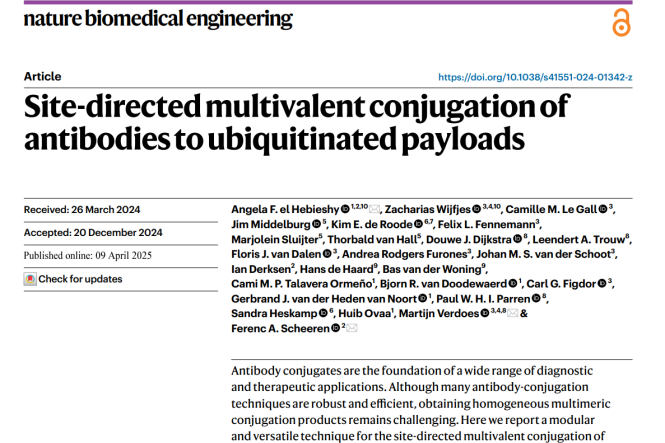“Antibodies have fundamental roles in research, diagnostic and therapy, in which conjugation with molecular cargo is often required. Traditional conjugation methods are limited in terms of control over the numbers and sites of modifications, resulting in heterogeneous products, which often affect the functionality and pharmacokinetics of antibodies.” While advances in site-specific conjugation techniques have addressed some of these conjugation issues, challenges such as long reaction times and inefficiency remain. The well-known small protein ubiquitin is post-translationally linked to target proteins through a well-orchestrated enzymatic cascade involving three key enzymes: an E1 activating enzyme, an E2 conjugating enzyme and an E3 ligating enzyme. “We hypothesized that this controlled enzymatic system could be exploited as a site-specific antibody conjugation method.”
In their multi-disciplinary study, entitled “Site-directed multivalent conjugation of antibodies to ubiquitinated payloads” published in Nature Biomedical Engineering, Angela El Hebieshy (Dept. of Cell and Chemical Biology, LUMC) and Zach Wijfjes (Dept.of Medical BioSciences, Radboudumc) et al. developed a modular approach for site-specific protein conjugation called ubi-tagging, which is based on ubiquitin biochemistry. “To validate this method, we engineered recombinant antibodies, Fab’ fragments and nanobodies to which we attached a donor or acceptor ubiquitin (the ubi-tag), and chemically synthesized ubiquitin derivatives carrying fluorescent dyes or antigenic peptides, which we attempted to conjugate using recombinant E1 and E2/3 enzymes. To our pleasant surprise, these “ubi-tagging” conjugation reactions proceeded extremely fast and efficient, without any side products.” What really sets apart this conjugation approach is the ability to perform sequential conjugations with high efficiency, enabling the generation of e.g., tri-valent Fab’ fragments.
“We used ubi-tagging to generate tetravalent bispecific T cell engagers and dendritic cell-targeted antigenic peptide fusions. Within 30 minutes, the method delivered fluorescently labelled Fab’ fragments and Fab’ multimers, as well as functional tetravalent bispecific T cell engagers that could direct T cells to kill target cells.” Compared to sortagging, an established chemoenzymatic bioconjugation approach, ubi-tagging demonstrated superior performance in conjugating hydrophobic, poorly soluble antigenic peptides to dendritic cell-targeted antibody fragments and nanobodies. “The ubi-tagged dendritic cell-targeted vaccines showed increased target specificity in vivo, as evidenced by robust T cell activation. Together the findings in our study highlight ubi-tagging as a versatile and efficient method for the synthesis of molecularly defined protein conjugates, with potential applications ranging from preclinical antibody development to vaccine engineering.”
“We dedicate this publication to Prof. Huib Ovaa, who passed away far to early 5 years ago. As pioneer in chemical biology, and ubiquitin (bio)chemistry in particular, he played a crucial role in the initiation of this project.”
Read the full article here: https://doi.org/10.1038/s41551-024-01342-z
Research Briefing about the article: https://www.nature.com/articles/s41551-025-01368-x
